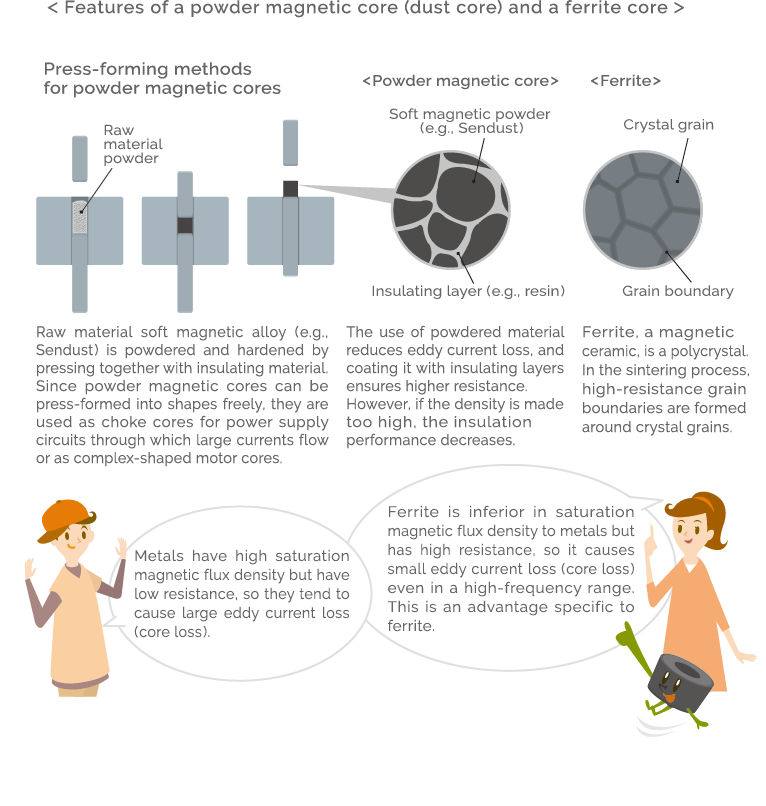Ferrite World
Vol. 4 Multilayer chip inductor created by a revolutionary new method

Ferrite and iron are a collection of multiple magnetic domains
When a magnet (permanent magnet) is divided into two pieces, these become two magnets, and when they are divided into four pieces, these become four magnets. Repeating this finally reaches the micro magnetic regions that cannot be further divided. These are called magnetic domains. A magnet may be regarded as a collection of many magnetic domains whose magnetic poles are aligned in the same direction. This is why a magnet shows magnetic properties even when divided.
While a permanent magnet retains its magnetism indefinitely, ferrite (soft ferrite) and soft iron are magnetic materials that are magnetized only when a magnetic field is applied, and that, therefore, should also be called temporary magnets. So, how is the characteristic of this temporary magnet explained at a micro level?
Ferrite and soft iron are also a collection of many magnetic domains. Unlike a permanent magnet, a temporary magnet arranges multiple magnetic domains with their magnetic poles oriented in alternating directions. For example, when multiple magnets are placed close together, they stick to each other and eliminate magnetic leakage from magnetic poles. This is because internally circulating magnetic flux creates a more stable, low-energy state. Similarly, in ferrite and soft iron, magnetic domains, which are micro magnets, collectively create a circulating structure of magnetic flux and eliminate magnetic leakage (multi-magnetic-domain structure). Thus, magnetic properties are not shown at a macro level. In other words, the multi-magnetic-domain structure is an energy-saving structure created by the magnetic material itself.
In ferrite and soft iron, the region occupied by each magnetic domain is not fixed. The boundary between magnetic domains is called a magnetic domain wall. When an external magnetic field is applied, magnetic domain walls move and the region occupied by the magnetic domains in the direction of the external magnetic field become dominant. Also, when the external magnetic field is removed, the magnetic domain walls move again to return to the original state. This is how ferrite and soft iron become a temporary magnet.
Ferrite and soft iron may also be regarded as a “sleeping magnet” that hides its magnetic properties. When an external magnetic field is applied, their magnetic properties are awoken, and when the external magnetic field disappears, they become sleeping magnets again. An advantage of ferrite is that its magnetic properties are good at awakening and falling asleep.
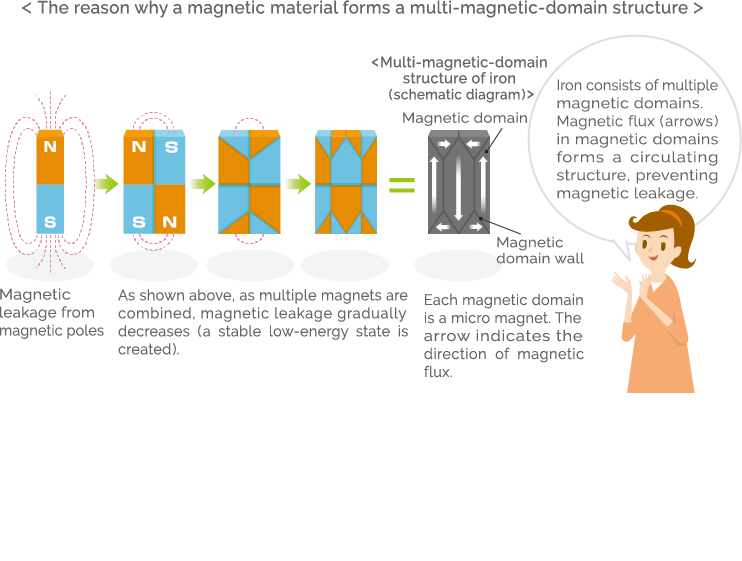
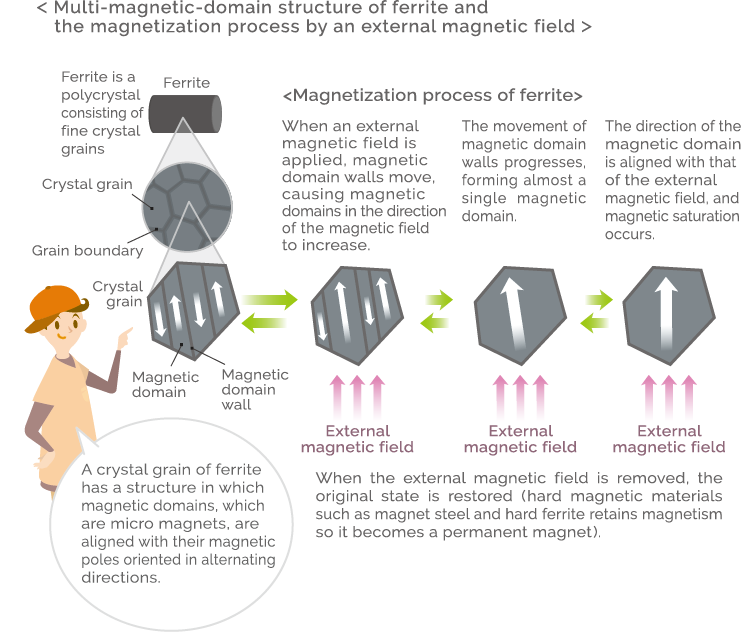
Where does the magnetism of a substance come from in the first place?
A magnetic domain, which is a micro magnet, can be observed using an optical microscope, and if it is further divided into smaller pieces, they have to be considered at the molecular or atomic level. So, where does the magnetism of a magnetic domain come from?
An electron orbits the atomic nucleus while rotating at high speeds, as the Earth orbits the Sun while rotating. This rotation of electrons is called spin. The main root of the magnetism of a substance is the spin of electrons. Since electrons have a negative charge, the rotation of electrons is equivalent to the flow of circular currents, and the circular currents produce a magnetic field in the direction determined by the right-handed screw rule. This means that a rotating electron itself has the properties of a miniature magnet. Assuming this is called an “electron magnet,” a magnetic domain, which is a micro magnet, is a collection of many electron magnets facing in the same direction.
While a rare earth element called, gadolinium shows ferromagnetism (the property of sticking to a magnet) at 20˚C or less, elements that show ferromagnetism at ambient temperatures are the following three: iron, cobalt, and nickel. These are called iron group elements. Here, a question arises. Why do only limited elements show ferromagnetism, even though every element has electrons?
When two bar magnets are put close together, they attract each other with their magnetic poles oriented in the opposite direction. This is because such behavior creates a more stable, low-energy state. Similarly, electrons on atomic orbitals also create a state where two electrons with opposite spins are paired. This means that the properties of an electron magnet are canceled out. This is also the reason why most substances are non-magnetic materials, which do not stick to a magnet.
However, in an iron group element, exceptionally one or more electrons that are not paired (unpaired electrons) exist on an orbital. In iron group elements, due to perfect intervals between atoms and between electrons, the electrons can coexist as unpaired electrons with the same spin direction. Therefore, in iron group elements, the properties of an electron magnet that unpaired electrons have are not canceled out, and appear as the properties of a ferromagnetic material at a macro level.
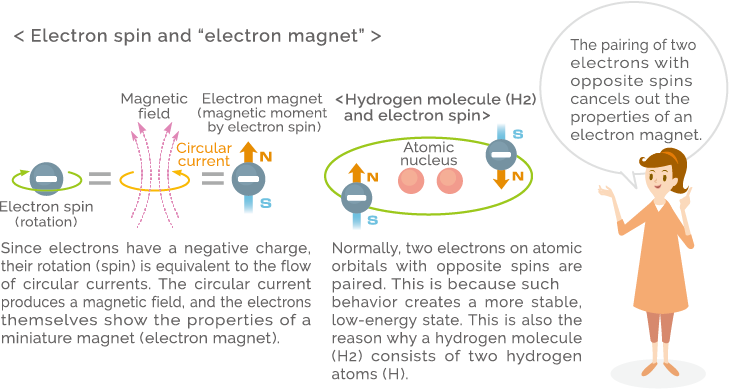
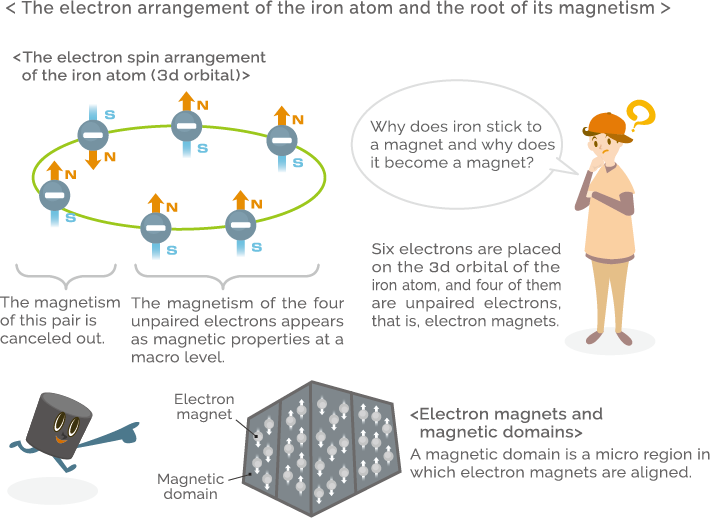
Multilayer chip inductors that TDK commercialized for the first time in the world
A coil through which currents are passed produces a magnetic field, and shows the same properties as a magnet. Inserting an iron or ferrite core into the coil significantly increases the magnetic properties, causing the coil to strongly attract iron. This is because magnetic materials such as iron and ferrite have the characteristic of collecting the surrounding magnetic flux. This is the principle of an electromagnet.
Coils, which originated from electric and magnetic experiments, started to be industrially used in electromagnets for electricity generators or motors in the middle of the 19th century. Wireless communication was put into practical use in the beginning of the 20th century, and radio broadcast was started in the 1920s. In order to sensitively receive weak radio waves, various coils were devised including cylinder-wound bobbin coils, cobweb-like spider coils, and woven-basket-like basket coils. The use of cores allows miniaturization of coils. The ferrite that TDK industrialized was a material suitable as cores for high-frequency coils. It had been used for wireless communication equipment since the pre-war period and has been mass-produced for cores of intermediate frequency transformers for superheterodyne radios after the war. When the age of TV began, the demand for ferrite further increased rapidly. Cathode-ray tubes deflect electrons emitted from the electron gun using the magnetic fields of the coil to shoot the electrons at a fluorescent screen to create images. The reason for the demand increase was that ferrite was necessary as the deflection yoke core for collecting the magnetic flux of the coil.
During the age of microelectronics, passive components such as capacitors have been made into SMDs (surface mount devices), and further miniaturization and mass-production of inductor products such as coils have been demanded.
In power supply systems carrying large currents, ferrite core wire-wound inductors are advantageous. Meanwhile, in signal systems carrying small currents, miniaturization and high-frequency characteristics are more required. In response to such market needs, in 1980, TDK developed the world's first multilayer chip inductors. It was generally impossible to form three-dimensional spiral coils with a layering method. However, TDK achieved this by developing a new revolutionary method through which a half pattern of a coil was printed on ferrite layers and these were layered alternately from side to side (printing and lamination method). (Afterward, TDK also established a sheet lamination method with multi-layered ferrite sheets on which internal electrode patterns are printed.) Despite being small chip components, the inductors offer sufficient performance thanks to the use of ferrite, which is an irreplaceable magnetic material.
TDK is a comprehensive electronic components manufacturer leading the world in magnetic technology



